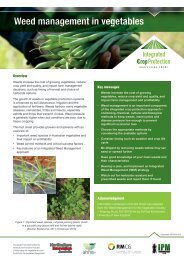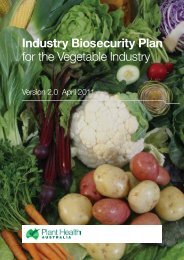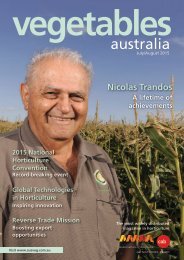vegetables
VA-NovDec2015
VA-NovDec2015
You also want an ePaper? Increase the reach of your titles
YUMPU automatically turns print PDFs into web optimized ePapers that Google loves.
moist during incorporation to<br />
obtain maximum benefit from<br />
the breakdown process.<br />
The crop is mulched to<br />
ground level in a single pass<br />
and then has two passes with<br />
a speed cultivator before a<br />
heavy roller seals the soil. This<br />
is important to ensure the gases<br />
released during the breakdown<br />
of the crop are activated against<br />
weeds and plant pathogens<br />
in the soil. Importantly, three<br />
passes must be done within 20<br />
minutes.<br />
The benefits<br />
Although David stresses that<br />
Caliente will not solve all of<br />
a grower’s soil problems, he<br />
has observed that the general<br />
health and fertility of the soil is<br />
enhanced through an increase<br />
in organic matter.<br />
“Caliente is not a silver bullet<br />
but another safe and effective<br />
means by which farmers can<br />
increase their soil fertility as<br />
well as a tool for combating soil<br />
borne pathogens and weeds,”<br />
David explained.<br />
Other benefits of using Caliente<br />
as a biofumigant include:<br />
• Suppression of soil borne<br />
diseases like Pythium and<br />
Rhizoctonia resulting in fewer<br />
seedling losses and less<br />
fungicide use in subsequent<br />
crops.<br />
• Weed suppression has been<br />
significant, due to the crop<br />
smothering weeds during crop<br />
growth and the biofumigation<br />
effects of incorporating the crop.<br />
Wild radish in particular had<br />
been largely suppressed.<br />
• Green manure: In this<br />
scenario, the incorporation of<br />
Caliente can be estimated as<br />
putting 35-40kg of phosphorus<br />
per hectare back into the soil in<br />
an organic form. As the Caliente<br />
crop is deep rooted, recycled<br />
nutrients that would normally be<br />
unavailable to subsequent crops<br />
are brought up from deep within<br />
the soil profile.<br />
• Improvement in the moisture<br />
holding capacity and infiltration<br />
of water into the soil. Where<br />
particular paddocks on the<br />
property had been prone to<br />
slipping and runoff after heavy<br />
rains, soils that had crops of<br />
Caliente incorporated were able<br />
to absorb the water without<br />
erosion or runoff.<br />
The Soil Wealth program will<br />
continue for another two years,<br />
with further field days planned<br />
for growers to witness practical<br />
and economical ways to<br />
improve the health of their soils.<br />
i<br />
This project has been<br />
funded by Horticulture<br />
Innovation Australia Limited<br />
using the National Vegetable<br />
Levy and funds from the<br />
Australian Government.<br />
For more information contact<br />
Danny Fyffe on 0437 353<br />
748, or visit www.ahr.com.au<br />
or www.soilwealth.com.au.<br />
Project Number: VG13078<br />
25<br />
Vegetables Australia November/December 2015<br />
The residues from David’s<br />
summer leaf cropping<br />
program act as fertilisers, while<br />
herbicides are unnecessary<br />
as the crop smothers all<br />
competition.<br />
The field day, held in<br />
September, was timed to<br />
coincide with the incorporation<br />
of the East’s Caliente crop,<br />
which usually occurs around<br />
120-130 days from sowing.<br />
The optimal stage to mulch the<br />
Caliente crop is at 20 per cent<br />
flowering, when the beneficial<br />
fumigant compounds are at<br />
their peak. The soil must be<br />
Caliente mustard chopped and<br />
ready for incorporation into the soil.<br />
TM





